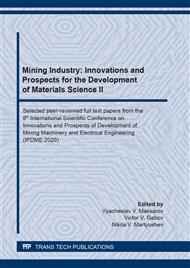[1]
G.K. Nikas, Modeling dark and white layer formation on elastohydrodynamically lubricated steel surfaces by thermomechanical indentation or abrasion by metallic particles, Journal of Tribology 137(3) (2016) 031504.
DOI: 10.1115/1.4029944
Google Scholar
[2]
F. Ansari, M.D. Ries, L. Pruitt, Effect of processing, sterilization and crosslinking on UHMWPE fatigue fracture and fatigue wear mechanisms in joint arthroplasty, Journal of the Mechanical Behavior of Biomedical Materials 53 (2016) 329-340.
DOI: 10.1016/j.jmbbm.2015.08.026
Google Scholar
[3]
R. Aghababaei, D. Warner, J. Molinari, Micromechanical origins of adhesive wear mechanisms: from asperity smoothing to debris creation Proceedings - STLE Tribology Frontier Conference (Chicago, USA, 2017) pp.217-220.
Google Scholar
[4]
R. Chattopadhyay, High silt wear of hydroturbine runners, Wear 162 (1993) 1040-1044.
DOI: 10.1016/0043-1648(93)90119-7
Google Scholar
[5]
V. Krasnyy, The use of nanomaterials to improve the wear resistance of machine parts under fretting corrosion conditions, IOP Conf. Series: Materials Science and Engineering 560 (2019) 012186.
DOI: 10.1088/1757-899x/560/1/012186
Google Scholar
[6]
J. Singh, S. Kumar, S. Mohapatra, Erosion wear performance of Ni-Cr-O and NiCrBSiFe-WC(Co) composite coatings deposited by HVOF technique, Industrial Lubrication and Tribology 71(4) (2019) 610-619.
DOI: 10.1108/ilt-04-2018-0149
Google Scholar
[7]
V. Maksarov, A. Khalimonenko, D. Timofeev, Machining quality when lathing blanks with ceramic cutting tools, Agronomy Research 12(1) (2014) 269-278.
Google Scholar
[8]
V. Maksarov, A. Khalimonenko, Quality assurance during milling of precision elements of machines components with ceramic cutting tools International Review of Mechanical Engineering 12(5) (2018) 437-446.
DOI: 10.15866/ireme.v12i5.14570
Google Scholar
[9]
J. Olt, Improving the precision of manufacturing power hydraulic cylinders of powered roof supports based on a vibration-damping tooling system Journal of Mining Institute 214 (2015) 71-84.
Google Scholar
[10]
K.Y. Chiu, F.T. Cheng, H.C. Man, Corrosion behavior of AISI 316L stainless steel surface-modified with NiTi, Surface Coating Technology 200 (2006) 6054-6061.
DOI: 10.1016/j.surfcoat.2005.09.009
Google Scholar
[11]
Y. Sun, V. Rana, Tribocorrosion behaviour of AISI 304 stainless steel in 0.5 M NaCl solution, Materials Chemical Physics 129 (2011) 138-147.
DOI: 10.1016/j.matchemphys.2011.03.063
Google Scholar
[12]
G. Koga, G. Zepon, Wear resistance of boron-modified supermartensitic stainless steel coatings produced by high-velocity oxygen fuel process, Journal of Thermal Spray Technology 28 (2019) 2003-2014.
DOI: 10.1007/s11666-019-00961-2
Google Scholar
[13]
R. Arji, D. Dwivedi, S. Gupta, Some studies on slurry erosion of flame sprayed Ni-Cr-Si-B coating Industrial Lubrication and Tribology, 61(1) (2009) 4-10.
DOI: 10.1108/00368790910929476
Google Scholar
[14]
M. Karimi, H. Salimijazi, M. Golozar, Effects of remelting processes on porosity of NiCrBSi flame sprayed coatings Surface Engineering, 32(3) (2016) 238-245.
DOI: 10.1179/1743294415y.0000000107
Google Scholar
[15]
A Ishkov, V. Malikov, Chemical reactions at high-speed HFC-boriding, Journal of Physics: Conference Series 1399(4) (2019) 044116.
DOI: 10.1088/1742-6596/1399/4/044116
Google Scholar
[16]
S.F. Dmitriev, A.V. Ishkov, Subminiature eddy current transducers for studying boride coatings, Journal of Physics: Conference Series 729(1) (2016) 012018.
DOI: 10.1088/1742-6596/729/1/012018
Google Scholar
[17]
V. Yankauskas, E. Katinas, R. Skirkus, V. Aleknyavichene, The method of hardening soil rippers by surfacing and technical–economic assessment, Journal of Friction and Wear 35 (2014) 270–277.
DOI: 10.3103/s106836661404014x
Google Scholar


